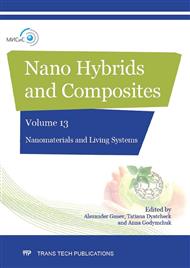[1]
C. Baker, Harnessing cerium oxide nanoparticles to protect normal tissue from radiation damage Transl Cancer Res, 2(4) (2013) 343-358.
Google Scholar
[2]
N. Zholobak, V. Ivanov, A. Shcherbakov, A. Shaporev, O. Polezhaeva, A. Baranchikov, N. Spivak, Y. Tretyakov, UV-shielding property, photocatalytic activity and photocytotoxicity of ceria colloid solutions, J Photochem Photobiol B, 102 (2011).
DOI: 10.1016/j.jphotobiol.2010.09.002
Google Scholar
[3]
J. Niu, Azfer A., Rogers LM, X Wang , PE Kolattukudy, Cardioprotective effects of cerium oxide nanoparticles in a transgenic murine model of cardiomyopathy, 73(3) (2007) 549-59.
DOI: 10.1016/j.cardiores.2006.11.031
Google Scholar
[4]
H. Ghaznavi, R. Najafi, S. Mehrzadi, A. Hosseini, N. Tekyemaroof , A. Shakeri-Zadeh, M. Rezayat, A. Sharifi, Neuro-protective effects of cerium and yttrium oxide nanoparticles on high glucose-induced oxidative stress and apoptosis in undifferentiated PC12 cells, Neurol Res., 37(7) (2015).
DOI: 10.1179/1743132815y.0000000037
Google Scholar
[5]
A. Popov, N. Popova, I. Selezneva, A. Akkizov, V. Ivanov, Cerium oxide nanoparticles stimulate proliferation of primary mouse embryonic fibroblasts in vitro, J. Mater. Sci. Eng. C, 68 (2016) 406–413.
DOI: 10.1016/j.msec.2016.05.103
Google Scholar
[6]
V. Selvaraj, N. Nepal , S. Rogers, N. Manne, R. Arvapalli, K. Rice, S. Asano, E. Fankhanel, J. Ma, T. Shokuhfar, M. Maheshwari, E. Blough, Inhibition of MAP kinase/NF kB mediated signaling and attenuation of lipopolysaccharide induced severe sepsisby cerium oxide nanoparticles, Biomaterials, 59 (2015).
DOI: 10.1016/j.biomaterials.2015.04.025
Google Scholar
[7]
B. Courbiere, M. Auffan, R. Rollais, V. Tassistro, A. Bonnefoy, A. Botta, J. Rose, T. Orsière, J. Perrin, Ultrastructural interactions and genotoxicity assay of cerium dioxide nanoparticles on mouseoocytes, Int J Mol Sci., 14(11) (2013) 21613-28.
DOI: 10.3390/ijms141121613
Google Scholar
[8]
N. Spivak, E. Shepel, N. Zholobak, A. Shcherbakov, G. Antonovitch, R. Yanchiy, V. Ivanov, Yu. Tretyakov, Ceria nanoparticles boost activity of aged murine oocytes, Nano Biomedicine & Engineering, 44 (2012) 188.
Google Scholar
[9]
Y. Marikaw, B. Vernadeth, Establishment of trophectoderm and inner cell mass lineages in the mouse embryo, Mol. Reprod. Dev., 76(11) (2009) 1019–1032.
DOI: 10.1002/mrd.21057
Google Scholar


